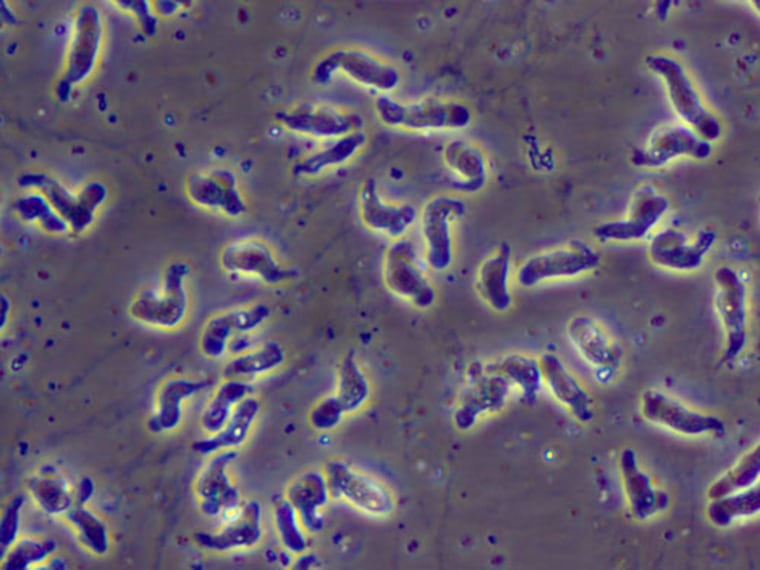The announcement early Thursday that a rare but potentially deadly brain-destroying amoeba was found in a parish water supply in Louisiana has put a community on edge and stoked fears straight out of zombie fiction.
The microscopic menace, Naegleria fowleri, craves warm freshwater and thrives in hot springs, swimming holes, lakes and even neti pots used to flush out sinuses. Officials say drinking water that it's in is safe, but if it slips into your nostrils, it could crawl up holes in the base of your skull and wage an all-out assault on your frontal lobe.
"If it gets in your brain, then you're hosed," said Dr. Clayton Wiley, director of the division of neuropathology at the University of Pittsburgh Medical Center.
Fortunately, medical professionals and disease experts say infections with this bug are exceedingly rare: It's been reported in just 132 people in the U.S. since 1962. And yet cases are nearly always fatal: Only three of those people survived.
Accordingly, officials in Louisiana are sounding the alarm about the tiny terrors swimming in a water system that serves 12,577 people.
Here's what we know about the amoeba:
Why is amoeba-tainted water safe to drink?
It’s probably not a great idea to sip on a Naegleria cocktail, but if you unwittingly do, don't fret: The acid in your stomach kills it, according to CDC spokeswoman Christine Pearson. But if tainted water gets up your nose, the amoeba can latch on to nasal mucosa and creep up the olfactory nerve, which carries smell signals to the brain.
"They can literally travel up these nerve cells like they're on a highway and get into the brain," said Dr. Nicole Iovine, an infectious disease doctor and director of Antimicrobial Management Program at the University of Florida. "That's really where they do the most significant damage."
Does the amoeba really 'eat' your brain?
The organism — roughly 10 micrometers in diameter — slinks up the olfactory nerve to the brain before reproducing exponentially. By the time the immune system reacts, the bug has already built up its defense against white blood cells.
"If you had it live under a microscope, you can watch it wander around and absolutely destroy cells," said Dr. Wiley. "It's extremely aggressive. It ravages brain tissue, and that's why it's earned the very graphic name 'brain-eating.' It's just a bad situation all around."
The infection caused by N. fowleri is called primary amoebic meningoencephalitis — PAM for short. It’s a severe inflammation of the brain — and there’s not an easy treatment. The early symptoms resemble a cold or flu, so diagnosis doesn't come quickly. And all the while, the amoeba feasts on brain cells.
“PAM is difficult to detect because the disease progresses rapidly so that diagnosis is usually made after death,” according to the CDC.
Who is most susceptible to infection — or worse?
If you've sustained a face injury — especially a fracture to your nasal passage — you're more likely to be vulnerable to infection, according to Iovine.
"If the bones that are supposed to separate the nasal cavity from the brain are broken or cracked, your face is essentially a wide-open gate" to the amoeba, Iovine said.
And while it's not entirely clear if children are more susceptible to Naegleria than adults, the statistics are stark: 84 percent of the 132 infections documented in the U.S. between 1962 and 2013 occurred in children under age 18, according to data from the CDC.
"The simple fact is that kids, especially little boys, are going to come into contact with the organism because of where they play and how they play," Iovine said. "They're going to be excited about dumping their heads in muddy, brackish water, where the amoeba thrives."
What can you do to protect yourself?
If you choose to take a dip in warm freshwater, the CDC recommends holding your nose shut, using nose clips, and keeping your head above water so you don't end up ingesting the gnarly bug.
But it's probably safest to stay out of the lakes and rivers brimming with amoebae, anyway. "I'm not a fear-mongerer," Wiley said, "but I tell you this: I wouldn't go swimming in the water after you've found something like that."
